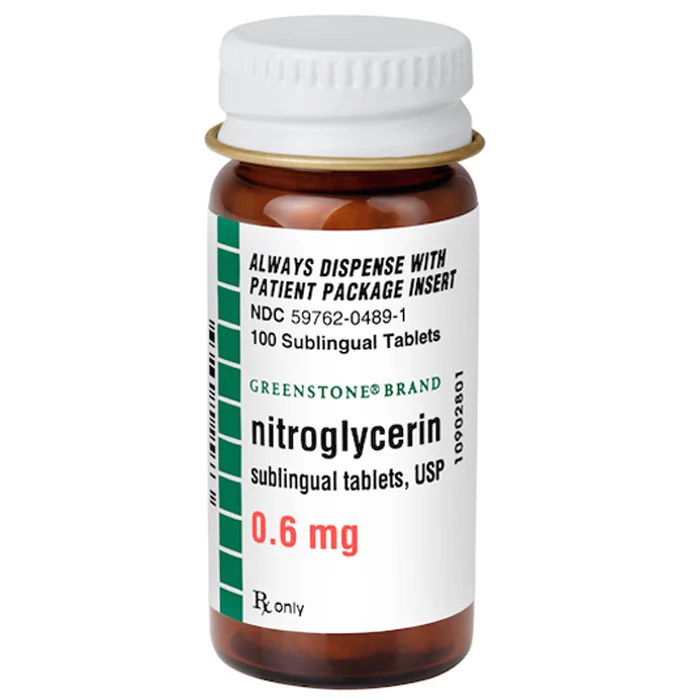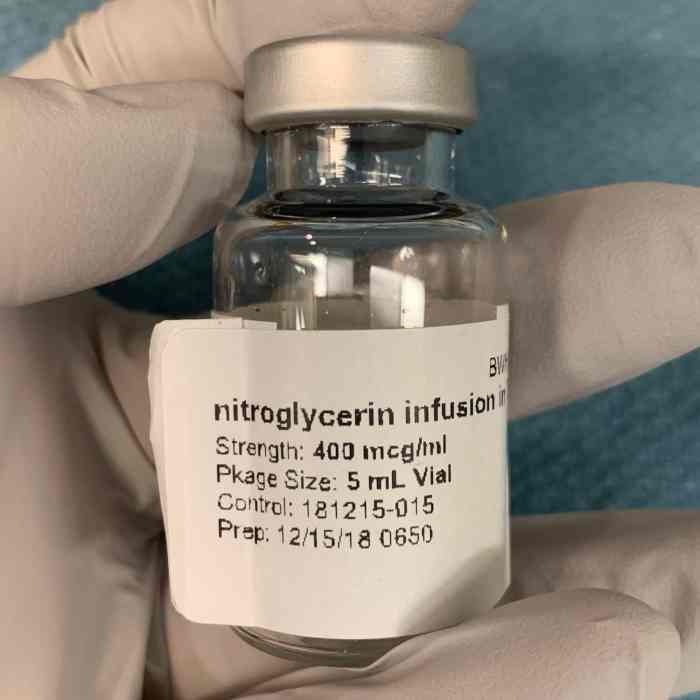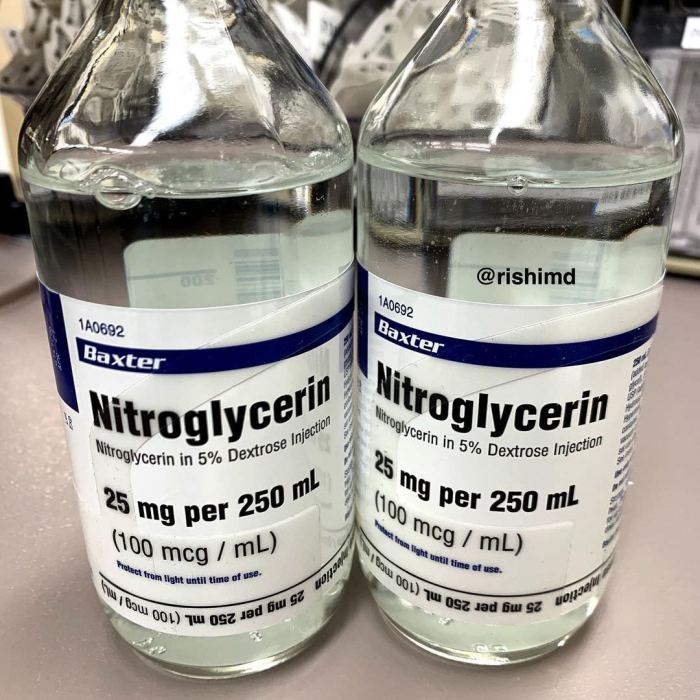Nitroglycerin, a volatile and explosive liquid, has a fascinating history that spans from its accidental discovery to its vital role in medicine and industry. This remarkable chemical, known for its potent explosive power, also possesses unexpected therapeutic properties, making it a subject of continuous scientific exploration.
Nitroglycerin’s journey began in 1847 when Italian chemist Ascanio Sobrero accidentally synthesized it while experimenting with a mixture of nitric acid and glycerol. This accidental discovery led to a rapid evolution in the field of explosives, transforming warfare, mining, and construction. However, its inherent instability and dangerous nature posed significant challenges for its safe handling and application.
Synthesis and Production of Nitroglycerin
Nitroglycerin, a highly explosive and sensitive compound, is synthesized through a controlled chemical reaction involving glycerol and a mixture of concentrated nitric and sulfuric acids. This process, known as nitration, involves the replacement of hydrogen atoms in glycerol with nitro groups (-NO2).
Chemical Reactions Involved in Nitroglycerin Synthesis
The synthesis of nitroglycerin involves a complex series of chemical reactions. The primary reaction is the nitration of glycerol, which occurs in the presence of concentrated nitric and sulfuric acids. The reaction can be represented by the following equation:
C3H5(OH)3 + 3 HNO3 → C3H5(ONO2)3 + 3 H2O
This reaction is highly exothermic, meaning it releases significant heat. The heat generated can cause the nitroglycerin to decompose explosively if not carefully controlled. The sulfuric acid acts as a catalyst, speeding up the reaction and also as a dehydrating agent, removing water from the reaction mixture. This removal of water helps to drive the equilibrium of the reaction towards the formation of nitroglycerin.
Industrial Process for Manufacturing Nitroglycerin
The industrial production of nitroglycerin involves a multi-step process, conducted under strict safety protocols. The process begins with the careful mixing of glycerol, concentrated nitric acid, and concentrated sulfuric acid in a specialized reactor. The reaction mixture is cooled to maintain a safe temperature, as the reaction is highly exothermic.
The nitration reaction is carried out in a series of stages, with the mixture being gradually added to the reactor to control the heat generated. The reaction is monitored closely using temperature sensors and other instruments to ensure that the temperature remains within safe limits.
After the nitration reaction is complete, the nitroglycerin is separated from the acid mixture by washing with water. This process removes any residual acids and ensures the purity of the nitroglycerin. The nitroglycerin is then stabilized by adding small amounts of stabilizers, such as sodium carbonate or calcium carbonate. These stabilizers help to prevent the nitroglycerin from decomposing prematurely.
Safety Measures in Nitroglycerin Production
The production of nitroglycerin is a hazardous process, requiring strict safety measures to prevent accidents.
- The entire process is conducted in a well-ventilated area to minimize the risk of explosions.
- The reaction mixture is carefully monitored to ensure that the temperature remains within safe limits.
- All equipment used in the process is regularly inspected and maintained to ensure that it is in good working order.
- Workers involved in the production of nitroglycerin are trained in safety procedures and are required to wear appropriate protective gear.
Challenges and Considerations in Nitroglycerin Production
The production of nitroglycerin presents several challenges and considerations:
- The high sensitivity of nitroglycerin to shock and heat requires careful handling and storage.
- The process is highly exothermic, requiring strict temperature control to prevent explosions.
- The corrosive nature of the acids used in the process necessitates the use of corrosion-resistant materials.
- The potential for environmental contamination from the acids and other byproducts requires careful waste management practices.
Applications of Nitroglycerin
Nitroglycerin, despite its explosive nature, has found diverse applications across various industries, ranging from construction to medicine. Its unique properties, including its potent explosive power and its ability to dilate blood vessels, make it a valuable substance with a wide range of uses.
Use in Explosives
Nitroglycerin is a highly energetic explosive, making it a key ingredient in dynamite and other blasting agents. Its explosive power is harnessed in various industries, particularly in mining and construction.
Applications in Mining and Construction
- Rock Blasting: Nitroglycerin-based explosives are commonly used in mining operations to break down large rocks and ores. The controlled detonation of these explosives allows for efficient extraction of valuable minerals from the earth.
- Construction: In construction projects, nitroglycerin-based explosives are used for demolition, clearing land, and excavating tunnels. The controlled blasts help shape the landscape and create foundations for buildings and infrastructure.
- Quarrying: Nitroglycerin is also used in quarrying to extract large blocks of stone for building materials. Its explosive power allows for precise and efficient extraction of these materials.
Use in Medicine
Nitroglycerin’s ability to dilate blood vessels has led to its use as a vasodilator in medicine. This property makes it effective in treating angina, a condition characterized by chest pain caused by reduced blood flow to the heart.
Treatment of Angina
- Sublingual Tablets: Nitroglycerin is available as sublingual tablets, which are placed under the tongue to quickly absorb into the bloodstream. These tablets are often used to relieve angina pain during an attack.
- Transdermal Patches: Nitroglycerin is also available as transdermal patches, which release the drug slowly into the bloodstream over several hours. These patches are used to prevent angina attacks by providing a continuous supply of nitroglycerin.
- Sprays: Nitroglycerin sprays are also available, providing a rapid-acting form of the medication for quick relief of angina pain.
Safety and Handling of Nitroglycerin

Nitroglycerin is an extremely sensitive and dangerous explosive. It is highly volatile and can detonate with the slightest impact, friction, or heat. Due to its inherent instability, it is crucial to exercise the utmost caution and follow strict safety protocols when handling this substance.
Safety Precautions and Protocols
Working with nitroglycerin demands strict adherence to established safety protocols. These protocols are designed to minimize the risk of accidental detonation and protect individuals from exposure to its toxic fumes.
- Personal Protective Equipment (PPE): Wearing appropriate PPE, including gloves, eye protection, and a respirator, is essential to prevent skin contact and inhalation of nitroglycerin.
- Storage: Nitroglycerin should be stored in a cool, dry, and well-ventilated area, away from any sources of heat, friction, or impact. It should be stored in small quantities and never in direct sunlight.
- Transportation: Transportation of nitroglycerin requires specialized containers and vehicles designed to handle explosives safely.
- Handling: Never handle nitroglycerin with bare hands. Use appropriate tools and equipment, such as spatulas or scoops, to avoid any contact with the substance.
- Static Electricity: Avoid static electricity buildup, which can ignite nitroglycerin. Use grounding equipment and wear clothing made from materials that do not generate static.
- Fire Suppression: Keep fire extinguishers readily available and ensure personnel are trained in their use. Nitroglycerin is highly flammable and can be ignited by a spark or flame.
- Emergency Procedures: Develop and implement emergency procedures for handling spills, accidents, or detonations.
Potential Hazards and Risks of Exposure
Exposure to nitroglycerin can have serious health consequences.
- Acute Toxicity: Inhalation of nitroglycerin fumes can cause headaches, dizziness, nausea, vomiting, and even death. Skin contact can lead to irritation, redness, and burns.
- Chronic Toxicity: Long-term exposure to nitroglycerin can damage the nervous system, liver, and kidneys.
- Detonation: As mentioned, the primary hazard of nitroglycerin is its explosive nature. Even small amounts can detonate with significant force, causing severe injuries or death.
Environmental Impact of Nitroglycerin
Nitroglycerin, a highly explosive compound, presents significant environmental concerns during its production, transportation, storage, and use. Its potential for pollution and contamination necessitates careful management and mitigation strategies to minimize its adverse effects on the environment.
Pollution and Contamination
Nitroglycerin’s environmental impact stems primarily from its potential to pollute air, water, and soil. Accidental spills, leaks, or explosions can release significant amounts of nitroglycerin into the environment, posing risks to human health and ecosystems.
- Air Pollution: The detonation of nitroglycerin releases various toxic gases into the atmosphere, including nitrogen oxides (NOx), carbon monoxide (CO), and particulate matter (PM). These pollutants contribute to smog, acid rain, and respiratory problems.
- Water Contamination: Accidental spills or leaks of nitroglycerin into water bodies can contaminate drinking water sources and harm aquatic life. Nitroglycerin is highly soluble in water and can persist in the environment for extended periods, posing long-term risks.
- Soil Contamination: Nitroglycerin can contaminate soil through spills, leaks, or improper disposal. It can leach into groundwater, contaminating drinking water sources and harming soil microorganisms essential for plant growth.
Minimizing Environmental Impact
Several measures can be taken to minimize the environmental impact of nitroglycerin:
- Safe Production and Handling: Implementing strict safety protocols and using appropriate equipment during production and handling can significantly reduce the risk of spills and leaks.
- Waste Management: Proper disposal of nitroglycerin waste is crucial to prevent environmental contamination. This includes using secure storage facilities and employing specialized waste treatment methods to neutralize or degrade the compound.
- Emergency Response: Having well-trained personnel and emergency response plans in place is essential to mitigate the environmental consequences of accidents or spills. This includes having procedures for containing and cleaning up spills and preventing further contamination.
- Environmental Monitoring: Regular monitoring of air, water, and soil in areas where nitroglycerin is produced, transported, or used is essential to detect and address any potential contamination. This helps ensure timely intervention and prevent long-term environmental damage.
Alternatives to Nitroglycerin

Nitroglycerin, while a powerful explosive, presents significant safety and handling concerns. As a result, researchers and engineers have developed various alternatives to nitroglycerin, each with its own advantages and disadvantages. These alternatives offer improved safety profiles, reduced environmental impact, and greater versatility in applications.
Alternative Explosives
The search for alternatives to nitroglycerin has led to the development of a wide range of explosives with varying properties and applications. These alternatives are designed to overcome the limitations of nitroglycerin, such as its sensitivity, volatility, and environmental impact.
- Dynamite: A common alternative to pure nitroglycerin, dynamite consists of nitroglycerin absorbed into a porous material like diatomaceous earth. This reduces the sensitivity of nitroglycerin, making it safer to handle and transport. Dynamite is widely used in mining, construction, and demolition.
- Ammonium Nitrate: A widely used explosive, ammonium nitrate is a white crystalline solid that is relatively inexpensive and stable. It is often combined with other ingredients to form blasting agents. Ammonium nitrate is commonly used in mining, quarrying, and construction.
- RDX (Cyclotrimethylenetrinitramine): A powerful explosive, RDX is more stable than nitroglycerin and is often used in military applications. It is also a key ingredient in some commercial explosives.
- PETN (Pentaerythritol Tetranitrate): Another powerful explosive, PETN is less sensitive than nitroglycerin and is used in detonators, blasting caps, and some military applications.
Comparison of Properties and Applications, Nitroglycerin
The alternatives to nitroglycerin exhibit a range of properties and applications, making them suitable for different purposes.
| Explosive | Properties | Applications |
|---|---|---|
| Nitroglycerin | Highly sensitive, powerful, volatile | Demolition, mining, blasting |
| Dynamite | Less sensitive than nitroglycerin, powerful, versatile | Mining, construction, demolition |
| Ammonium Nitrate | Stable, inexpensive, less powerful than nitroglycerin | Mining, quarrying, construction |
| RDX | Powerful, stable, insensitive | Military applications, demolition |
| PETN | Powerful, less sensitive than nitroglycerin, stable | Detonators, blasting caps, military applications |
Advantages and Disadvantages of Alternatives
The use of alternatives to nitroglycerin offers several advantages and disadvantages that must be carefully considered for each application.
- Advantages:
- Increased Safety: Many alternatives are less sensitive and more stable than nitroglycerin, reducing the risk of accidental detonations and improving safety during handling and transportation.
- Reduced Environmental Impact: Some alternatives, such as ammonium nitrate, have lower environmental impacts than nitroglycerin, minimizing the release of harmful pollutants.
- Versatility: Different alternatives offer varying properties and applications, allowing for tailored solutions to specific needs.
- Disadvantages:
- Lower Power: Some alternatives, like ammonium nitrate, may have lower explosive power than nitroglycerin, requiring larger quantities to achieve the same effect.
- Cost: Certain alternatives, such as RDX and PETN, can be more expensive than nitroglycerin.
- Environmental Concerns: While some alternatives have lower environmental impacts than nitroglycerin, others, such as RDX, can still pose environmental risks if not handled properly.
Research and Development of Nitroglycerin
The research and development of nitroglycerin continues to be an active area of investigation, with ongoing efforts focused on improving its synthesis, handling, and applications. Scientists and engineers are exploring innovative approaches to enhance the safety, efficiency, and effectiveness of this powerful compound.
Advancements in Nitroglycerin Synthesis
Advancements in the synthesis of nitroglycerin aim to improve its production efficiency, reduce its environmental impact, and enhance its stability. One area of focus is the development of alternative synthesis methods that utilize greener and more sustainable reagents. This involves exploring new catalysts and reaction conditions to minimize the use of hazardous chemicals and reduce waste generation. Additionally, researchers are investigating alternative starting materials, such as bio-based glycerol, to create a more sustainable and environmentally friendly production process.
Improved Handling and Storage of Nitroglycerin
Improving the handling and storage of nitroglycerin is crucial for ensuring its safe and responsible use. Researchers are exploring novel materials and technologies to enhance its stability and reduce its sensitivity to detonation. One promising approach involves the development of microencapsulation techniques to encapsulate nitroglycerin within protective layers, minimizing its sensitivity to external stimuli. Additionally, ongoing research focuses on developing safer and more efficient methods for transporting and storing nitroglycerin, including the use of specialized containers and advanced monitoring systems.
Emerging Technologies and Innovations
Emerging technologies are revolutionizing the way we synthesize, handle, and apply nitroglycerin. Nanomaterials, for example, offer exciting possibilities for controlled release and targeted delivery of nitroglycerin, potentially leading to more effective and personalized medical treatments.
Cultural and Societal Impact of Nitroglycerin

Nitroglycerin, a powerful explosive with a complex history, has left an indelible mark on society, influencing various aspects of culture, technology, and even our understanding of the world. Its impact has been both positive and negative, shaping the course of history and leaving behind a legacy that continues to resonate today.
Portrayal in Literature and Film
Nitroglycerin has been a recurring theme in literature and film, often serving as a symbol of power, danger, and the destructive potential of human ingenuity. Its explosive nature has captivated imaginations, leading to its frequent depiction in works of fiction.
- Literature: In literature, nitroglycerin has been used to create dramatic tension and explore themes of power, control, and the consequences of unchecked ambition. For example, in the classic novel “The Count of Monte Cristo” by Alexandre Dumas, nitroglycerin plays a crucial role in the protagonist’s quest for revenge. The explosive’s ability to cause widespread destruction is a key element in the novel’s suspenseful plot.
- Film: In film, nitroglycerin has often been depicted in action and thriller genres, where its explosive potential is used to create high-stakes sequences. Films like “The Rock” and “Die Hard With a Vengeance” feature nitroglycerin as a central plot device, highlighting its power and the danger it poses. These depictions, while often exaggerated for entertainment purposes, have contributed to the public perception of nitroglycerin as a powerful and volatile substance.
Ethical Considerations and Debates
The use of nitroglycerin has sparked ethical debates and concerns, particularly in relation to its application in explosives and its potential for misuse.
- Explosives: The use of nitroglycerin in explosives has raised ethical questions about the potential for civilian casualties and the destruction of property. The devastating effects of nitroglycerin-based explosives in wars and terrorist attacks have fueled debates about the responsible use of this powerful substance.
- Misuse: The potential for misuse of nitroglycerin has also been a source of concern. Its availability and accessibility, combined with its explosive nature, have raised questions about the need for strict regulations and controls to prevent its use in illegal activities.
Nitroglycerin, with its paradoxical nature, remains a subject of constant fascination and scientific inquiry. Its explosive potential has revolutionized various industries, while its therapeutic properties have transformed the treatment of cardiovascular diseases. The ongoing research and development surrounding nitroglycerin continue to unveil new insights into its complex behavior and potential applications, promising further advancements in diverse fields.
Nitroglycerin, a powerful explosive, is often associated with dynamite. However, it also has medicinal uses, particularly in treating angina. A completely different kind of medication, Ibrance , is used to treat certain types of breast cancer. Both nitroglycerin and Ibrance are powerful substances, but they are used in vastly different ways and for vastly different purposes.